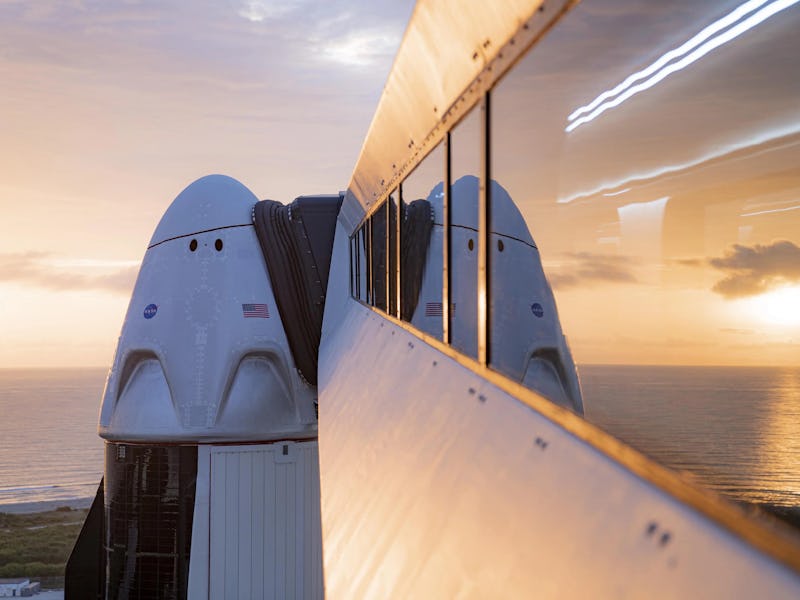SpaceX: After Inspiration4, Elon Musk hints at Starlink upgrade for Dragon
SpaceX's Inspiration4 mission has returned to Earth, and Elon Musk has ideas for how to improve the capsule for next time.

SpaceX’s Inspiration4 mission returned to Earth over the weekend, and Elon Musk already has ideas for how to make the next mission even better.
The mission, which launched Wednesday, was the first all-civilian trip to orbit. The group spent three days inside the Crew Dragon capsule conducting scientific experiments and observing the Earth flying past before splashing down to Earth on Saturday.
The team had plenty to keep them occupied, but future missions could offer a bit more digital stimulation. Writing on Twitter before the capsule splashed down off the coast of Florida, SpaceX CEO Elon Musk suggested that future flights could offer free wireless internet access courtesy of its Starlink service.
“Dragon will have a food warmer & free wifi next time :),” Musk wrote in response to an Inspiration4 post showing the array of foods on offer during the mission.
Want to find out more about SpaceX’s plans and Inspiration4? Subscribe to MUSK READS+ for exclusive interviews and analysis about spaceflight, electric cars, and more.
These creature comforts could help in SpaceX’s goal to expand access to space. While the sixties-era space race sent a handful of carefully picked astronauts on daring adventures, companies like SpaceX aim to send more people than ever to tackle a variety of missions.
Inspiration4 was the company’s third crewed mission, but the first non-NASA mission. SpaceX now plans a series of subsequent civilian missions in partnership with Axiom Space, with the first scheduled for no earlier than January 2022.
SpaceX Crew Dragon: Wireless upgrades on the way
The Crew Dragon already has a communication link with the ground, but evidence suggests it’s limited. While observers on Earth were treated to images and video of the crew enjoying their trip, the otherwise engaged group of four were notably absent from Twitter for the duration of the mission.
The Inspiration4 team poses for a selfie.
For Inspiration4, NASA provided communications between the ground and capsule through the Near Space Network. This connects missions with various agencies and commercial entities up to two million kilometers (1.24 million miles) away from Earth. This network brings down around 30 terabytes of data per day.
NASA’s network uses ground stations to offer line-of-sight communications with missions. It also uses relay satellites, placed in geosynchronous orbit, that can help provide continuous communications.
Jared Isaacman, the missions’ funder and a passenger on board, explained on Twitter that the crew only had limited opportunities to use the network, remarking that they only had so many ground station passes to transmit video because NASA and other agencies had priority. “I suspect a lot of footage will be released shortly,” he said. “We had quite a few cameras on board.”
But ahead of the mission’s return, Musk suggested the company could also connect its capsules to the Starlink internet service. SpaceX’s designed its under-development constellation to offer high speed and low latency service to almost anywhere in the world with a view of the sky, but Musk claimed the system could also provide services to customers located above and below.
“We’d use our Ka parabolics or laser links for Dragon, Starship, or other spacecraft as soon as they got above cloud level,” Musk wrote.
The service has received a warm response from beta testers on Earth. Customers have reported speeds of over 200 megabits per second, faster than many existing satellite internet connections. SpaceX’s long-term goal is to offer speeds of up to 10 gigabits per second.
The Inverse analysis — SpaceX’s plans could make Crew Dragon missions more comfortable, but it’s notable that the company plans to use these upgrades for its upcoming Starship rocket.
The fully-reusable ship, currently under development at the company’s Texas facility, aims to send up to 100 people or 100 tons into space at once. SpaceX plans a trip with Japanese billionaire Yusaku Maezawa with eight passengers around the Moon in 2023. SpaceX also wants to use Starship to send the first humans to Mars, a stepping stone to establishing a full-blown city.
Starlink could make internet access better than ever for rural areas on Earth, but it could also make the new era of space travel far more comfortable.
SUBSCRIBE TO MUSK READS+, A PREMIUM NEWSLETTER THAT COVERS THE WORLDS OF ELON MUSK, SPACEX, TESLA, AND EVERYTHING IN-BETWEEN.